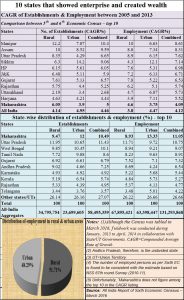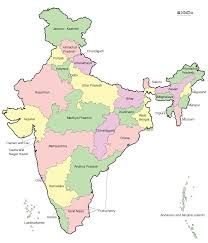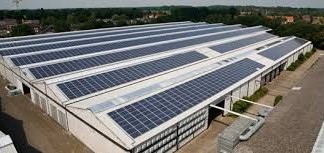6th Economic Census: Maharashtra stumbles again, while other states generate wealth
All state governments are known to tout their successes. All of them claim that they are business friendly. They claim that they want to create jobs for their people. All of them claim that they generate wealth. Really?
 A recent government of India publication, “All India Report of Sixth Economic Census – March 2016” offers a huge amount of data. The Census debunks such claims of many states, and even the country itself.
A recent government of India publication, “All India Report of Sixth Economic Census – March 2016” offers a huge amount of data. The Census debunks such claims of many states, and even the country itself.
Take the top ten states which excelled on two scores – employment growth and growth in the number of enterprises. And there are surprises galore.
First, as pointed out in these columns even earlier (http://www.asiaconverge.com/2016/05/tax-kitty-maharashtras-slip-is-showing/ and http://asiaconverge.com/2016/03/642/) the most industrialized state in the country – Maharashtra – comes out quite poorly.
True, it has the largest share of the workforce in the country. But that is a legacy factor. The person who created the maximum jobs in Mumbai was David Sassoon in mid 19th century. He set up 17 textile mills in Mumbai, thus accounting for almost two-thirds of all employment in Mumbai. He transformed the city from being just a trading centre into a manufacturing hub as well. Then came the bankers and the stockmarkets. And the rest is history.
But watch incremental job creation, or the ability to let new enterprises gain a foothold in the state. That is where Maharashtra’s slip begins to show. It does not figure among the top 10. It saw the number of enterprises grow by just 5% each year, and employment grow by 4.09%. In other words, the state saw employment generation just 2% over the normal population growth. Considering that so many migrants flocked to Mumbai in search of jobs, it is no surprise that the local population got left out. The fault was not of the migrant worker. The flaw lay in the state’s policies for not creating the right incentives for job creation.
Do bear in mind, that the migrant is a hardy worker. He has left his home town. That itself requires enterprise and determination. He has to prove himself in a relatively alien territory, because he often comes without a support system in place. Locals tend to take it easy. That is why state governments need to create enough jobs to cater to the aspirations of locals too. Else, they will begin supporting divisive sons-of-the-soil parties, and poison the atmosphere. What the latest Economic Census shows is that Maharashtra did not become either business friendly, or even employee friendly. It comes 18th on the list, though it appears to be #11 in the chart alongside.
Also take a look at the states that created the maximum growth in jobs. They were Manipur, Assam, Uttar Pradesh, Sikkim Himachal Pradesh, J&K (that is a surprise) and Gujarat. They were industry-friendly, and even people-friendly – certainly more proactive than Maharashtra.
But the country — as a whole – has a lot to be ashamed about. Number of enterprises grew by just 4.46% a year. And employment grew at a lacklustre 4.12% a year. Ironically, this was when the economy was supposed to have been growing quite well. Urbanisation too was growing at a rapid pace. The possible explanation could be that the government focussed more on large enterprises which were not great employment generators. The huge loans given out to companies that have not done well, and have now begun to show up as NPAs, was another factor.
As the Economic Census points out, of the 58.5 million establishments found to be in operation, as many as 34.8 million establishments (59.48%) were found in rural areas. Thus more jobs are needed – and were created — in rural areas. The opportunities lie there. In theory, Maharashtra too tried to do this. Unfortunately, money meant for the rural sector – for irrigation projects, for farms etc – where cornered by people close to the political class. It is only now that the magnitude of the scam is beginning to get known. And even this could be just the tip of the iceberg.
That small and medium enterprises remain the sector where both the need and the opportunities lie is again suggested by the numbers. “During the period between the two Economic Censuses (2005 & 2013), non-agricultural establishments grew at the rate of 28.97%, while agricultural establishments grew at the rate of 115.98%.” Many of the agricultural establishments were in areas associated with farming, but not in farming itself.
This is where the present government’s vision of “power for all” may help generate more job opportunities in rural areas, provided that the funds are not “stolen”. However, with the biggest scamsters still not behind bars, one is not sure any more whether such hopes are justified.






































COMMENTS